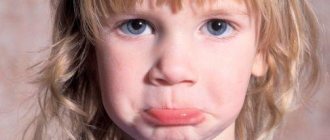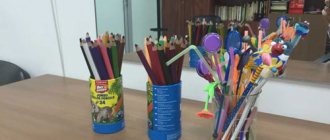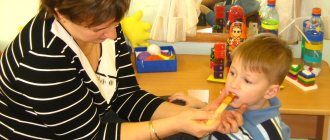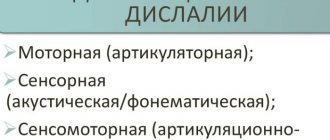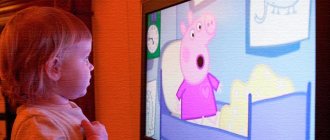Children with SSD (severe speech impairment) are a separate category of children with normal development of the hearing system and with unimpaired basic intelligence, but with significant speech deviations. Such defects can have a negative impact on the psyche. Speech therapy determines that this deviation leads to the child’s inability to master the school curriculum.
Some of these children have difficulty speaking. They have a very limited vocabulary. There are severe cases when a child cannot put together a pair of words at all. It may seem that this is directly related to reduced intellectual development, but the problem lies in the lag in mental development. In the future, this will manifest itself in difficulties with arithmetic and literacy.
In the extreme form of TNR, lexical and grammatical underdevelopment and difficulties with coherent speech can be traced. This results in inhibited thinking, difficulties in reading and writing.
Expert opinion
Margarita Sergeevna S.
Speech pathologist and speech pathologist with 15 years of experience working in various speech correction centers with children of different ages.
The main problems with TNR are stuttering, alalia, and aphasia.
Classification of severe speech disorders
Speech therapists currently identify two classification options for speech development difficulties in preschool children. Based on the pathologies, the following clinical picture was formed:
- problem with pronunciation of sounds (stuttering, dysarthria);
- problem with speech timbre (bradylalia, tachylalia);
- voice problem (aphonia, dysphonia);
- problem with reading and writing.
Based on the diagnosis, specialists determine individual treatment methods for each child.
In the Russian Federation, another classification of speech defects in children has been created. It is called psychological-pedagogical:
- general, phonetic and phonemic difficulties with speech development;
- stuttering.
For a complete and correct diagnosis, speech disorders in both classifications should be considered. In this case, you will be able to choose the right course of treatment.
Do you notice a speech disorder in your child?
Not really
HIA I, II, III, IV, V, VI, VII, VIII types and their interpretation
Decoding categories of disabilities in education
The pedagogical decoding of types of disabilities is set out in the Federal Law on Education of the Russian Federation.
He describes the specifics of the categories of “special” schoolchildren and the special conditions for receiving education for each of them. Developmental features are diagnosed by PMC. These include vision, speech, and musculoskeletal disorders, mental retardation (MDD), intellectual development disorders, behavioral and communication disorders, including ASD and ADHD, and complex developmental disorders. If confirmed, the PMPK recommends specific special conditions for the child’s education.
Decoding the categories of disabilities in medicine
A medical decoding of the categories of disabilities is given in the “International Classification of Functioning, Disability and Health of Children and Adolescents. ICF-CY" of the World Health Organization. She defines disorders as problems in the development of physiological and (or) psychological functions of the body (mental, sensory, speech) and its structures (nervous, digestive, endocrine, cardiovascular, immune, respiratory systems), their significant deviations and loss. Forms of violations also include delays and delays in the development of children and adolescents.
The ICF-CY defines 5 levels of violations in percentage terms (from 0-4% - with no or minor violations, to 96-100% - with absolute ones) and 4 levels of delays, taking into account that delays may disappear. Impairments and delays are recorded by codes assigned to body functions and structures, learning and application abilities, social relationships and environmental influences. The classification is published on the WHO website.
The summary table “Classification of children with disabilities” on the site rosuchebnik.ru provides a more detailed description of the features of all categories of disabilities.
OVZ according to the Federal State Educational Standard
Types of disabilities according to the Federal State Educational Standard are determined in accordance with the options for adapted basic educational programs (AOEP) for “special” students.
- deaf, 4 options AOOP NOO
- hearing impaired, 3 options
- blind, 4 options
- visually impaired, 3 options
- with musculoskeletal disorders (LODA), 4 options
- with mental retardation (MDD), 3 options
- with severe speech impairment (SSD), 3 options
- with autism spectrum disorders (ASD), 4 options
- with mental retardation (intellectual impairment), 2 options(3)
The Federal State Educational Standard recommends educating such children in inclusive schools and Centers for psychological, pedagogical, medical and social assistance (PPMS). PPMS centers are most often organized on the basis of correctional schools and are gradually replacing them. At the same time, correctional schools of 8 types continue to fulfill their mission. Let's get acquainted with the categories of their students.(2)
If it's difficult with a child
A new book by a famous family psychologist, winner of the Russian Presidential Prize in the field of education, author of the bestsellers “What to do if ...” and “What to do if ... 2” is addressed to parents of children and adolescents with behavioral characteristics. The publication will help you find a common language with your child, navigate difficult situations and conflicts, get out of them with dignity, maintain patience, restore understanding and peace in the family. Children don't listen to their parents about how much this world is worth. In an attempt to teach a “careless child” how to “behave”, responsible parents arm themselves with the latest psychological “tricks”, learn modern techniques for sitting on buckwheat, and children in response only become more and more irritable and disobedient.
Buy
I category. Hearing-deaf, deaf children without speech
Children with profound, persistent bilateral hearing loss: those who lost their hearing early, those who were born with hearing impairments, or those who lost their hearing before speech development. They do not perceive speech and cannot master it on their own. They need special training to talk. Such children perceive the world through sight and touch. Their thought processes are based not on speech, but on images and actions. Therefore, they have difficulty identifying causes and effects, properties and relationships. Their attention and memory are characterized by instability and low capacity due to fatigue.
In teaching speech, special acoustic and sign language equipment plays a major role. And although speech remains undeveloped, dominated by words denoting objects and very few words describing qualities and movement, they can still speak. Even if he makes mistakes in sounds, replacing words with similar sounds.
Children communicate with each other using gestures and try to transfer such communication into the world of hearing, imitating various objects and their signs with gestures and facial expressions. Sometimes this is perceived as aggression, and an equally aggressive response occurs. This is one of the reasons why children with deafness have low self-esteem.
II category. Hearing impaired children
Children with partial hearing loss, hearing loss and varying degrees of speech underdevelopment. Children who have retained residual hearing and independent speech. They continue to accumulate vocabulary.
The development of their mental and cognitive processes depends on how early they lost their hearing. The retained low level of auditory perception creates the illusion that one can rely on it, but the information received is greatly distorted.
The main task in teaching them is to develop visual perception and teach them to concentrate on the lips of the speaker, while simultaneously teaching them to read. As a result, the stability of attention will increase and visual memory will begin to develop.
Unlike deaf children, hard of hearing children have high and even inflated self-esteem, since any slightest achievement is perceived by the adults around them as an incredible success.
III and IV categories. Visual impairment (considered together)
Blind children, including those born blind and blind before the age of 3, visually impaired and late blind, with strabismus and amblyopia.
Blind children perceive the world around them exclusively by hearing and touch, and have increased vibration sensitivity. Retaining residual vision through vague and distorted images. This way of cognition impoverishes thought processes and interferes with their integrity. Children have difficulty determining the distance and location of not only objects, but also their own. As a result, they do not have clear, confident judgments.
Training for this category is based on creating a polysensory experience: the missing analyzer is replaced by the activation of others. First of all, through speech. But it must be taken into account that visually impaired children acquire speech skills later than their healthy peers, their vocabulary is poor and spoken words do not always coincide with real images. Any verbal description for them requires tactile exploration.
Studying develops their unstable attention, which does not have a target orientation. Its volume, concentration and arbitrariness increase. The same is with memory, primarily verbal-logical.
Blind and visually impaired children can be conflict-prone, unrestrained, and have no goals. But communication, joint educational and work activities with visionary peers develop their independence and competitiveness.
V category. Severe speech pathology
Children are mute, with phonetic-phonemic underdevelopment of speech and impaired pronunciation of individual sounds: alalia, aphasia, dysarthria, rhinolalia. With alalia, normal hearing and intelligence are preserved, but due to organic lesions of the speech areas of the brain, speech development is disrupted. Agrammatisms appear, difficulties in reading and writing appear, and vocabulary decreases.
Aphasia is characterized by the destruction of already formed speech when the motor or speech center of the brain is affected. In the first case, speech is completely absent or is preserved in the form of separate phrases and words with pronunciation defects. In the second, the differentiated perception of sounds and words is disrupted. The child ceases to understand what is said to him, but normally perceives non-speech sounds.
Dysarthria and rhinolalia are problems with pronunciation. With dysarthria - due to insufficient development of the speech apparatus, with rhinolalia - due to anatomical defects in the structure of the organs of articulation. As a result, all mental processes suffer, with the exception of logical, semantic and visual memory.
Learning takes place through the development of motor skills with the help of gymnastics, rhythm, and music. As a result, stable cognitive interest and adequate self-esteem are restored.
What else should I read?
Adapted program for children with disabilities
Development of the potential of children with disabilities through electronic textbooks
Children with disabilities at school: how to create comfortable conditions for their learning and communication?
Inclusive education for autistic children
VI category. Musculoskeletal disorders
Children with cerebral palsy, congenital and acquired deformities of the upper and lower extremities, flaccid paralysis of the upper and lower extremities, paresis and paresis of the lower and upper extremities. Lack of movement prevents them from perceiving reality through vision and kinesthetics. They have more developed verbal thinking compared to visual and effective thinking. The system of forming concepts and abstractions lags behind.
There are often problems with hearing, leading to a decrease in auditory memory and auditory attention. There are alalia and dasathria.
It is useful for such children to combine education with feasible work activity. It teaches them to switch attention, reduces lethargy, and gives them a sense of importance.
VII category. Children with mental retardation
Children with the possibility of intellectual development, but a slow pace of mental processes, high exhaustion, difficulty in assimilating knowledge: mental underdevelopment, mental retardation, damaged mental development, deficient development, distorted development (RAD, ADHD)
Common problems are slow, inconsistent perception, and delayed verbal and logical thinking. It is difficult for them to analyze and generalize. As a result, speech suffers, lacking clarity and logic.
Children with mental retardation are characterized by involuntary impulsive behavior and infantilism combined with a low level of cognitive processes, including memory and attention. The causes of infantilism lie in problems of the endocrine and nervous systems, and a delayed pace of mental development.
When training, it is necessary to take into account their physiologically determined fatigue, frequent changes in activity and passivity. If they are given interesting tasks that do not require mental strain, and if an atmosphere of calm and goodwill is created, they show results in solving intellectual problems that are close to the norm.
VIII category. Deviation of intellectual development.
Children with profound underdevelopment of cognitive processes. Most often in the form of oligophrenia (congenital mental defect syndrome) of 3 types. Only children with retardation and mild correctable mental retardation are capable of learning.
Although their perception is distorted, difficult to reconstruct and does not have sufficient meaning, and the level of thinking is very low, they master speech, albeit with grammatical and phonetic errors. Children learn to write, read, and count. But the main form of work with them is labor training and, subsequently, assistance in finding employment.
Regardless of the category of disabilities to which the child belongs, Russian inclusive schools, primary medical education, and correctional schools create all the conditions for their “special” students “to receive, without discrimination, quality education, for the correction of developmental disorders and social adaptation”
#ADVERTISING_INSERT#
Reasons for the development of pathology
Very often it is difficult to establish the cause of a deviation based on one of the signs, since the problem consists of a number of factors. Experts identify the following main causes of TNR: :
- damage to the child’s head during childbirth or in the first years of life;
- health problems during pregnancy. Various infectious diseases of the expectant mother;
- fetal hypoxia;
- bad atmosphere in the family. Rude attitude towards a child;
- excessive strictness in education;
- common diseases in children (rickets, cerebral palsy, Down syndrome, asthenia).
A child may not develop his speech well if he has deaf parents. The most dangerous periods for disruption of speech development are 1-2 years and 5-6 years.
Important: in some cases, impaired speech development may be due to viral and bacterial infections.
Psychological and pedagogical characteristics of a preschooler with STD
Tatyana Vlasova
Psychological and pedagogical characteristics of a preschooler with STD
Child's name date of birth XX. XX. XXXX
Conclusion of the OPMPC dated XX. XX. XXXX TNR
Speech environment.
Favorable, moderate control over the upbringing process on the part of parents. Parents periodically consult with the teaching staff.
General motor skills.
There is imperfection of general motor skills, inaccuracy of movements, coordination of movements is impaired, it is difficult to maintain balance when necessary, and there is difficulty regulating the tempo of movements.
The state of manual motor skills.
The leading hand is the right. Manual motor skills are underdeveloped. The child's finger movements are uncoordinated and the ability to make small, precise movements is not sufficiently developed.
Articulatory apparatus.
The anatomical structure of the organs of the articulatory apparatus without anomalies. The volume and accuracy of movements performed suffers.
Speech motor skills are underdeveloped. Cannot maintain the position of the organs of articulation.
Speech is slurred. The voice is quiet.
A child’s understanding of speech at the everyday level. Cannot always follow simple instructions. Repeated repetition is necessary, sometimes with demonstration of action.
The child does not know how to concentrate on any task for a long time; incapable of distributing and switching attention from one type of activity to another. Difficulty remembering educational material.
Does not establish cause-and-effect relationships; requires constant assistance from an adult when completing a task; the sequence of actions when performing a task is not established or established with help; inconsistent and illogical in his judgments.
He is selective about tasks; if he doesn’t like a task, he doesn’t complete it (turns away)
.
Passive and active vocabularies are characterized by poverty . Many words are used in an approximate meaning (for example, “glass - cup”
).
Generalized concepts have not been mastered. Doesn't name the seasons or the order of the days of the week.
The use of verbs, adjectives, and adverbs suffers most. does not know colors, geometric shapes, quantities or confuses them, does not correlate a word with an object; has difficulty recognizing an object.
Severe agrammatisms are observed in speech.
Phonemic awareness is impaired; sound analysis and synthesis are not developed.
Sound pronunciation. Impaired: whistling, hissing, sonorators (L, R, affricates.
The syllabic structure of the word is distorted. There are omissions of syllables. Words with complex syllabic structures are distorted.
Speech is phrasal.
Significant difficulties when composing a story based on a series of plot pictures. Difficulties in perceiving the plot image (cannot perceive the plot as a whole, lists what is depicted)
.
Retelling doesn't work.
Relationships with surrounding peers and elders occur out of necessity (if he is asked for something or he asks for something)
. Prefers to observe peers. Knowledge about the environment is limited. Doesn't assimilate program material.
Education of children with SLD in kindergartens
Children diagnosed with SLD are able to study in specialized preschool institutions or in regular kindergartens, where a speech therapist works. Such an institution is obliged to develop an AOEP (adapted basic general education program) for children with special needs in preschool educational institutions. Such a program is created individually in
every kindergarten.
In such a development, aspects of the psychophysical and speech development of each individual child should be considered. It takes into account the child’s capabilities, a plan for his correction and adaptation in the social sphere. This means that the kindergarten applies the state program for children with SLD, but at the same time makes adjustments taking into account the personality characteristics of each child. Approval of such a document is carried out by the manager and the management council.
Each preschool institution can operate several such directives at once. Mandatory items must be:
- system for assessing children's successes and achievements;
- a list of items and actions to achieve your goals;
- developed extracurricular development program;
- expected results and results of the work performed.
Important: it is advisable to send children with SLD to a preschool institution where similar children have previously studied. Educators and teachers already have considerable experience in communicating with such children. It will be much easier for them to find a common language with the child.
It will also be useful for such children to be in society with ordinary children. They will be able to learn a lot and will not feel isolated from society.
Don't miss: What is ZPRR and how to correct it?
Article:
Speech disorders are a fairly common phenomenon not only among children, but also among adults.
The causes of these disorders are very diverse. But they are the result of untimely or ineffective treatment. The most complex are organic disorders (dysarthria, alalia, rhinolalia) and, to a lesser extent, functional disorders (dyslalia). Against this background, in most cases, such children have, to one degree or another, disturbances in sound pronunciation, vocabulary, grammar, and phonemic processes. All these violations, if not corrected in time in childhood, cause difficulties in communicating with others, and in the future entail certain personality changes in the development chain “child – teenager – adult”, i.e. lead to the development of complexes in children, preventing them from learning and fully revealing their natural abilities and intellectual capabilities. The required amount of assistance to a child speech therapist depends on the nature of the diagnosis. Some speech disorders disappear with age, some of them can be eliminated with a little help from a speech therapist working with parents or at a speech center in a children's clinic or in a regular preschool institution. Children with the most severe speech impairments require long-term, systematic help from a speech therapist in speech groups in kindergartens.
Professor R.E. Levina, studying the most severe speech disorders, identified and described in detail a category of children who have insufficient development of all language structures. In children of this group, pronunciation and discrimination of sounds are impaired to a greater or lesser extent, the system of morphemes is not fully mastered, and, consequently, the skills of inflection and word formation are poorly acquired, the vocabulary lags behind the norm in both quantitative and qualitative indicators, and suffers coherent speech. This systemic disorder is called “general speech underdevelopment” (GSD).
General speech underdevelopment (GSD) is a systemic disorder that is characterized by disturbances in sound pronunciation, phonemic
perception, syllabic structure, sound content of words, grammatical structure of speech. Children in this group have a poorly developed vocabulary, coherent speech suffers, and deviations in general and articulatory motor skills are observed. In this case, disruption of the formation of vocabulary and grammatical structure of speech is especially complex and persistent.
In many cases, OHP is a consequence of the complex influence of various factors, for example, hereditary predisposition, organic failure of the central nervous system (sometimes mild), and an unfavorable social environment during sensitive periods of speech development.
The most complex and persistent type of speech disorder is general speech underdevelopment caused by early organic brain damage.
In terms of its clinical composition, this category unites different children. So, according to E.M. Mastyukova, three main groups can be distinguished among them:
- the so-called uncomplicated variant of general speech underdevelopment, when there are no clear indications of damage to the central nervous system. Underdevelopment of all components of speech in children is accompanied by “minor neurological dysfunctions,” such as insufficient regulation of muscle tone, insufficient motor differentiation, etc.; Children exhibit some emotional-volitional immaturity, poor regulation of voluntary activity, etc.
- a complicated variant of general speech underdevelopment, when the speech defect itself is combined with a number of neurological and psychopathological syndromes, such as increased intracranial pressure syndrome, cerebroasthenic or neurosis-like syndrome, movement disorder syndromes, etc. Children in this group have low performance, a violation of certain types of gnosis and practice, severe motor awkwardness, etc.
- severe and persistent underdevelopment of speech, caused by organic damage to the speech zones of the cerebral cortex. As a rule, this group consists of children with motor alalia.
A detailed study of children with ODD revealed extreme heterogeneity of the described group in terms of the degree of manifestation of the speech defect, which made it possible to determine three levels of speech development of these children.
The first level of speech development, characterized in the literature as “the absence of common speech.”
Quite often, when describing the speech capabilities of children at this level, the name “speechless children” is used, which cannot be taken literally, since such a child uses a number of verbal means in independent communication. These can be individual sounds and some of their combinations - sound complexes and onomatopoeia, snatches of babbling words (“mud”, “sina” - “machine”). When playing them, the child retains predominantly the root part, grossly violating the sound-syllable structure
words. Sometimes a babbling word is completely different from its original, since the child is able to correctly convey only the prosodic features of its pronunciation - stress, number of syllables, intonation, etc. (“tutya” - “hand”). The speech of children at this level can be replete with so-called diffuse words that have no analogues in their native language (“kia” - “jacket”, “sweater”, etc.)
A characteristic feature of children with the 1st level of speech development is the possibility of multi-purpose use of their available means of language: these onomatopoeias and words can denote both the names of objects and some of their characteristics, and actions performed with them (for example, the word “bika”, pronounced with with different intonations, means “car”, “driving”, “beeping”).
These facts indicate an extreme poverty of vocabulary, as a result of which the child is forced to resort to the active use of paralinguistic (i.e., non-linguistic) means - gestures, facial expressions, intonation: instead of “give me the doll,” the child says “yes” and accompanies the babbling word with a hand gesture , pointing to the required toy, instead of “I won’t sleep”, he says “neither”, turning his head negatively and frowning on his face, etc. However, even these amorphous sound complexes and words are difficult to combine into some semblance of a babbling phrase.
Here is a description of the toy (car), compiled according to the leading questions of the speech therapist: “Manya. Bika. Bika. Seine. Seine. Bika" (“Small. Car. Rides. Black wheel. Beeps”).
Along with this, children have a clearly expressed deficiency in the formation of the impressive side of speech (i.e., speech understanding). It is difficult to understand even some simple prepositions (in, on, under, etc.), grammatical categories of singular and plural (give me a spoon, give me spoons), masculine and feminine gender, past and present tense of verbs, etc. Summarizing all of the above, we can conclude that the speech of children at level 1 is difficult to understand for others and has a strict situational attachment.
Children with level 1 speech development should receive speech therapy assistance from 2.5 to 3 ages.
The second level of speech development, characterized in the literature as “The beginnings of common speech.”
A distinctive feature is the appearance of 2-3, and sometimes even 4-word phrases in children’s speech. (“Yes tena nika.” - “give me the yellow book.” “De kasya isya asom” - “Children color the leaves with a pencil.”) At first glance, such phrases may seem completely incomprehensible, but a detailed analysis of speech samples indicates the use, along with amorphous words, words with clearly expressed categorical characteristics of gender, person, number and even case. By combining words into phrases and phrases, one and the same child can both correctly use the methods of coordination and control, and violate them: “five cookies” (five dolls), “sinya kalandas” (blue pencil), “de yucca” (two hands), etc.
Such errors, along with attempts to use diminutive forms, indicate the initial stage of assimilation of the morphemic system of the language.
In children's independent speech, simple prepositions and their babbling variants sometimes appear. In a number of cases, omitting a preposition in a phrase, a child with the 2nd level of speech development incorrectly changes the members of the sentence according to grammatical categories: “Utya ezi a tui.” - “The duck lies under the chair.” “Asik ezi tai.” - “The ball is on the table.”
However, as before, some simple prepositions (on, over, for, etc.) and complex ones (because of, from under, through, between, about) cause difficulties in understanding, differentiation and, naturally, use.
Compared to the previous level, there is a noticeable improvement in the state of vocabulary not only in quantitative, but also in qualitative parameters: the volume of used nouns, verbs and adjectives is expanding; Some numerals and adverbs appear.
However, the insufficiency of the morphological system of the language, in particular, word-formation operations of varying degrees of complexity, significantly combines the capabilities of children, leading to errors in the use and understanding of prefixed verbs (instead of “poured” - “did not pour”), relative and possessive adjectives (instead of “mushroom” - “mushrooms”, instead of “fox” - “fox”, etc.), nouns with the meaning of the character “thrush” - “where they drink milk”), etc.
Along with word-formation errors, difficulties are observed in the formation of generalizing and abstract concepts, a system of synonyms and antonyms. The polysemous use of words and their semantic (meaning) substitutions are still encountered.
The speech of children with level 2 often seems incomprehensible due to gross violations of sound pronunciation and the syllabic structure of words. Thus, the pronunciation and discrimination of a large number of phonemes - up to 16-20 - may suffer. When reproducing words of 2-3 or more syllables, children disrupt their sequence, rearrange them, omit or, conversely, add syllables, and distort their sound (“siped” - bicycle, “kititi” - bricks).
Coherent speech is characterized by insufficient transmission of certain semantic relationships and can be reduced to a simple listing of events and objects seen. For example, when composing a story based on a series of plot pictures “Bear and Honey”, a child experiences difficulties in conveying their sequence and content. “Mitya is going crazy. Walking through the EU. Yesi honey. Mitya went crazy. Ityt pteiy. Then zyaia. Mitya bezi. Pteii itit." (“The bear saw a hole (hollow). He walks through the forest. There is honey. The bear climbed into the hole. The bees fly. Then they sting. The bear runs. The bees fly.)
Children with level 2 speech development receive speech therapy assistance from the age of 3-4 years.
The third level of speech development is characterized by extensive phrasal speech with elements of underdevelopment of vocabulary, grammar and phonetics.
Typical for this level is the use of simple common sentences, as well as some types of complex sentences. At the same time, their structure may be disrupted, for example, due to the absence of main or minor members of the sentence. In independent speech, the number of errors associated with changing words according to the grammatical categories of gender, number, case, person, tense, etc. has decreased.
However, specially targeted tasks make it possible to identify difficulties in the use of neuter nouns, future tense verbs, and in agreeing nouns with adjectives in indirect cases.
As before, the understanding and use of complex prepositions will be clearly insufficient, which are either completely omitted or replaced with simple ones (instead of “got up from the table” - “got up from the table”).
At this level, word-formation operations become available to children. The study of this category of children shows that there really is a positive dynamic in mastering the system of morphemes and methods of manipulating them. A child with level 3 ODD understands and can independently form new words using some of the most common word-formation models. Along with this, the child finds it difficult to choose the correct productive basis (“a flowerpot” is “potty”, “a person who builds houses” is “a homemaker”), uses inadequate affixal elements (instead of “washer” - “moichik”, instead of "fox" - "fox") Very often, a child’s attempts to carry out word-formation transformations lead to a violation of the sound-syllable organization of the derived (i.e., newly formed) word, instead of “drew” - “sayaval”, instead of “washer” - “mynchik”.
Typical for this level is an inaccurate understanding and use of general concepts, words with abstract and abstract meaning, as well as words with figurative meaning. Vocabulary may seem sufficient in everyday everyday situations, but a detailed examination may reveal that children do not know such parts of the body as the elbow, bridge of the nose, nostrils, eyelids. The tendency towards multiple semantic substitutions still persists (instead of “basket” - “bag”, instead of “gloves” - “these, on the hands, which”).
A detailed analysis of children’s speech capabilities makes it possible to determine difficulties in reproducing words and phrases of a complex syllabic structure, for example, “the plumber is fixing the water supply system” - “water and water is tinting water water”, “the guide is conducting an excursion” - “kusavod is paving ikusi”).
Along with a noticeable improvement in sound pronunciation, there is insufficient differentiation of sounds by ear: children have difficulty completing tasks on identifying the first and last sound in a word, selecting pictures whose names contain a given sound, etc. Thus, in a child with level 3 OHP, the operations of sound-syllable analysis and synthesis turn out to be
insufficiently formed, and this, in turn, will serve as an obstacle to mastering reading and writing.
Samples of coherent speech indicate a violation of logical-temporal connections in the narrative: children can rearrange parts of the story, skip important elements of the plot and impoverish its content. For example, how a child composed a story based on a series of paintings “Winter Fun”: “The children were walking in the yard. And there is snow. They took coats, hats, took these in their hands, which... The boy skated, and this one skated too. We made neneviki (snowmen). Then he took the dog on a sled. No, it's not him, it's someone else. And the other one sat on the slide, and then ran here (points with his hand at the picture “skating rink”).
Children with level 3 speech development are sent to speech therapy groups from the age of 5 for 2 years. And if the correctional program is completed in full, there is a high probability that they will be able to study in a comprehensive school.
Parents need to remember that a speech defect negatively affects the development of neuropsychic and cognitive activity, therefore, children with ODD often experience a delay in the rate of mental development, which manifests itself in the immaturity of higher mental functions, in addition, a deficiency of speech means creates problems in the adaptation of children at the beginning of the school period. Therefore, we cannot neglect the correctional assistance that specialists provide to children with ODD even in preschool age.
But a number of shortcomings can be corrected at home. The family usually corrects the child when he pronounces this or that sound or word incorrectly, but sometimes they do this with mockery or irritation. Correcting speech errors must be approached very carefully. Under no circumstances scold your child for his poor speech and do not demand that he immediately repeat correctly a word that is difficult for him. Such methods lead to the child refusing to speak at all and withdrawing into himself. Mistakes must be corrected tactfully and in a friendly tone. You should not repeat a word your child pronounces incorrectly; it is better to give a sample of its pronunciation.
Parents should also pay attention to the fact that when communicating with a child, especially in early and early preschool age, one should not pronounce words distorted, use truncated words or onomatopoeias instead of common words (“bibika”, “lyalya”, “yum-yum” and etc.) This will only slow down the assimilation of sounds and delay the timely mastery of the dictionary. The frequent use of words with diminutive suffixes, as well as words that are inaccessible to the child’s understanding or complex in their sound-syllable composition does not contribute to the development of a child’s speech. A child masters speech by imitation. Therefore, it is very important that adults monitor their pronunciation, speak slowly, and pronounce all sounds and words clearly and correctly.
If your child pronounces any sounds, words, or phrases incorrectly, you should not imitate him, laugh, or, conversely, praise him. It is also impossible
demand the correct pronunciation of sounds during that period of a child’s life when the process of formation and automation is not completed.
While studying with your child at home, reading a book to him, looking at illustrations, invite him to answer questions about the content of the text, retell the content of a fairy tale (story), and answer what is shown in the picture. If the child makes mistakes, you should not interrupt him, give him the opportunity to finish the statement, and then correct his mistakes.
Remember that only as a result of your, parental, selfless work at home, the child achieves success.
Problems in teaching children with SLI in schools
With this diagnosis, students tend to slow down the perception of information. Their performance is at a reduced level. Associative connections between auditory, visual and speech abilities are disrupted. There are difficulties in organizing voluntary activities. Also, when deciphering the diagnosis of TNR, memory deterioration and deviations in spatial orientation are manifested. Students have poor self-control. Impairments in fine motor skills, visual and auditory coordination are noticeable.
Expert opinion
Margarita Sergeevna S.
Speech pathologist and speech pathologist with 15 years of experience working in various speech correction centers with children of different ages.
Due to problems with speech, difficulties in understanding and mastering material in the Russian language appear. As a result, difficulties arise with writing.
If a child is unable to master educational material, his motivation to overcome obstacles decreases. Children with SLD have decreased self-esteem and decreased desire for further education. All this leads to an inability to adapt to the school environment.
If qualified speech therapy and medical and psychological assistance are not provided, children will not be able to receive quality education.
Speech therapist diagnoses
In recent years, unfortunately, speech disorders in children are becoming more and more common. A pediatrician, neurologist, or psychologist can identify speech development disorders at their appointments. The speech therapist diagnoses speech development, collects anamnesis and, on this basis, makes a speech therapy conclusion. What diagnoses can a speech therapist make and what directions in the correction of speech defects are important to consider to compensate for them will be discussed in this article.
ZRR
– delayed speech development. This is a pathology that occurs in children with intact intellectual abilities, in which the timing of the appearance of speech is disrupted, there is a poor vocabulary, pronunciation defects, and the grammatical design of speech and the formation of sounds suffer. Sometimes parents do not notice the delay in the child’s speech development. They believe that speech will appear spontaneously, until they realize that their baby speaks much less and worse than his peers. His speech appears late or develops slowly and is difficult to understand. He cannot voice his thoughts, although he understands what is said to him. During the consultation, the speech therapist determines the degree of delay in speech development, recommends a consultation with a neurologist (to exclude severe organic disorders), and may also refer you for a consultation to an ENT specialist (for a hearing test), a pediatrician (indicators of general physical health are also important for the timely development of higher mental functions). Children with speech development delays are recommended to take logorhythmic classes, classes with a psychologist, speech therapist (group and/or individual) to stimulate speech activity.
Alalia
is a systemic underdevelopment of speech, which is based on difficulties in language acquisition. This is an organic disorder of a central nature, in which there is a delay in the maturation of nerve cells in certain areas of the cerebral cortex. Alalia is caused by organic lesions of the speech areas of the cerebral cortex in the intrauterine development of the fetus or the early period of child development. The child’s speech develops with gross deviations or does not develop at all. A comprehensive examination by a neurologist, ENT specialist, psychiatrist, or pediatrician will help make a diagnosis. During the consultation, the speech therapist determines the form of alalia (motor, sensory, mixed) and recommends visiting a speech therapy kindergarten. Classes for alalia with a speech therapist, defectologist, neuropsychologist, psychologist are mandatory and should be regular, systematic and under the supervision of a neurologist.
ONR –
general speech underdevelopment. This is a systemic disorder in which the formation of all components of speech suffers. The child speaks, but speech suffers at the sound, syllabic, and grammatical levels; the semantic component of both understanding speech and independent speech expression is disrupted. It can act as an independent disorder, or as part of other disorders, or be a consequence of other speech pathologies. Experts distinguish 3 (4) levels of OHP. Correction of this disorder most successfully takes place in a speech therapy kindergarten or in a speech therapy group in a kindergarten. Observation by a neurologist and, as part of general correctional work, classes with a neuropsychologist or defectologist are recommended.
Dysarthria
- occurs as a result of organic damage to the central nervous system, brain in the prenatal or early period of a child’s development and manifests itself in a violation of the pronunciation side of speech. The main clinical signs of dysarthria are impaired muscle tone in the speech muscles, limited possibility of voluntary articulatory movements (movements of the speech organs), impaired voice production and breathing. Speech dysarthria can be an independent speech defect, and can also be part of more complex speech disorders. Dysarthria is the case when people say “porridge in the mouth.” The pronunciation side of speech and sound pronunciation suffer greatly. Parents may notice not only unclear pronunciation of sounds, but also lack of coordination in children, clumsiness, untidiness, awkwardness in articulation and fine motor skills; There may be increased salivation (salivation of varying degrees), possible asymmetry in the work of the muscles of the tongue, cheeks (when sticking out the tongue and performing specified movements, puffing out the cheeks, etc.), nasalization of the voice (nasal, nasal tone of speech). During diagnosis, a speech therapist determines the type of dysarthria, paying attention to the state of the muscles of the articulatory apparatus (hyper/hypotonicity) for the correct selection of the type and methods of articulatory massage. Correction of such a disorder will be more successful if a neurologist, physiotherapist, massage therapist, exercise therapy specialist, and neuropsychologist participate in the work. Children are recommended for regular speech therapy sessions using speech therapy massage and taping.
FFNR
– phonetic-phonemic speech disorder. This is a disruption of the processes of formation of the pronunciation side of the native language in children with various speech disorders associated with impaired perception (phonemic hearing) and pronunciation of sounds. This category includes children with normal hearing and intact intelligence.
The speech of a child with FFDD is characterized by multiple sound substitutions, confusions, omissions, distortions of sounds (tea - tai, brush - mesh, cat - koska, scooter - famokat, furniture - nebel, astronaut - kosenat, etc.) Impaired reproduction of sounds in a child with such pathology is associated with insufficient discrimination of both those sounds whose pronunciation is impaired, and those that are pronounced correctly, but belong to different phonetic groups. Along with this, the child has errors in the syllable structure and sound content of words (button-button, code-frying pan, niga-book, mot-bridge). That is, the child can skip entire syllables, rearrange them, and skip sounds in words. The success of correctional work with such a disorder depends on regular, systematic individual sessions with a speech therapist.
Stuttering in children is a disorder of the tempo-rhythmic aspect of speech, caused by repeated convulsions in the articulatory, vocal or respiratory parts of the speech apparatus. Stuttering in children is characterized by “getting stuck” on individual sounds, their repeated, involuntary repetition, accompanying movements, speech tricks, logophobia, and vegetative reactions. Children with stuttering should be examined by a neurologist, speech therapist, psychologist, or psychiatrist. Correction of stuttering in children includes a medical and health complex (compliance with the regimen, compliance with neurologist’s prescriptions, massage, exercise therapy, psychotherapy) and a system of speech therapy classes.
Dysgraphia, dyslexia
– writing impairment, reading impairment.
Dysgraphia is a violation of written speech skills, when partial difficulties arise in mastering writing. Characteristic signs are persistent, repeated errors in writing (mixing letters based on similar characteristics, omissions of letters, “mirror” writing of letters, omission of letter elements, kinetic errors).
Dyslexia
- This is a violation of the formation of reading skills. It is associated with difficulties in the formation of speech components and improper operation of the analyzing systems (the child may mix up letters while reading, there may be a violation of reading the syllabic structure of a word, while reading, the student makes mistakes in letters that have similar optical features, has difficulty assimilating the visual image of the letter , violation of grammatical forms when reading, reading by guess, the student poorly and for a long period of time connects letters into syllables or spends a long time on the syllabic type of reading).
Errors have a different nature and the form of dysgraphia and dyslexia will be determined by a speech therapist during diagnosis. To complete the information, it is also important to consult a neurologist, ophthalmologist, ENT specialist, or neuropsychologist. This diagnosis is given to schoolchildren, but the prerequisites for writing and reading disorders may appear in the preschool period. Parents should pay attention if:
- the child is unable to hold the spoon and writing utensils correctly for a long time;
- he poorly distinguishes and reproduces sounds;
- speech develops more slowly than that of peers or does not correspond to age standards;
- there are problems with the development of fine motor skills;
- there are disturbances in coordination of movements;
- difficulties with maintaining attention (the child needs to frequently switch to different types of activities);
- the child quickly gets tired of activities.
In preschool and school age:
- the child encounters difficulties in reproducing rhythm and memorizing poetry;
- difficulty repeating a series of syllables or numbers;
- the child ignores signs and letters on the left or right;
- difficulties with remembering letters and writing them;
- the child has difficulty merging letters into syllables and has difficulty reading words out loud;
- sees one thing and pronounces something else (letters, words, numbers);
- reading by guesswork, reading fluency is impaired, difficult to read complex words, distorts words when reading, lacks expressiveness, poorly understands the meaning of what is read;
- replaces, rearranges, mirrors letters and numbers, omits letters, does not add words, syllables, distorts words, adds extra letters or syllables;
- the child has poor handwriting, does not see the boundaries of the sheet, does not follow the boundaries set by the teacher when writing;
- cannot determine the boundaries of words and sentences;
- knows the rules but forgets to apply them when writing.
Classes for the correction of dyslexia and dysgraphia are conducted by a speech therapist. It would be right to include classes with a neuropsychologist.
Technology and methods of teaching students
Along with general requirements, schools are faced with more in-depth tasks to help children with speech disorders. Among them:
- correction of oral and written speech;
- in the process of eliminating defects, take into account the mental development of each child;
- professional training.
The educational process involves the allocation of significant time devoted to the work activities of schoolchildren. Thanks to this approach, several problems are solved simultaneously. First of all, the adaptation of children with disabilities to society, the formation of personality and preparation for life outside of school. This aspect also includes the physical development of children with SLD.
Education of children with special needs
This category includes children with disorders:
- hearing;
- vision;
- speeches;
- musculoskeletal system.
The teaching methodology includes:
- identification of various developmental pathologies;
- after the diagnosis is made, immediately provide psychological and pedagogical support;
- create a special rehabilitation program;
- identify developmental features and create a self-education plan;
- involve the child’s family and environment in the recovery process;
Expert opinion
Margarita Sergeevna S.
Speech pathologist and speech pathologist with 15 years of experience working in various speech correction centers with children of different ages.
Education of children with special needs is carried out in special schools and boarding schools.
Technology of compensatory education
Statistics indicate that more than 20% of children have various delays. If you do not start eliminating defects in time, the child will lose adaptation in the educational process.
The following sensory systems act as compensatory functions in children with SLI:
- tactile sensations;
- hearing (provided there are no impairments);
- vision (if no problems are identified);
- motor function.
Success in eliminating speech defects directly depends on the state of the listed systems and the ability to use them.
Equally important for children with SLD is pedagogical work aimed at:
- voluntary training;
- adapted content of educational material;
- additional classes;
- involvement of the child’s compensatory capabilities in the learning process;
- the pace of delivery of material depending on the speed of assimilation.
The main elements of successful rehabilitation are considered to be a loyal and understanding attitude towards students.
Psychological characteristics of children with SSD article on correctional pedagogy
Psychological characteristics of children with SLI.
K.D. Ushinsky said that the native word is the basis of all mental development and the treasury of all knowledge. Timely and correct acquisition of speech by a child is the most important condition for full mental development and one of the directions in the pedagogical work of a preschool institution. Without well-developed speech, there is no real communication, no true success in learning.
Children with SLD are a special category of children with developmental disabilities who have no primary intellectual impairment, preserved hearing, but have significant speech defects that affect the development of the psyche.
Defects can affect various components of speech, for example, a decrease in the intelligibility of speech, others affect the phonemic side of the language and are expressed in defects in sound pronunciation, insufficient mastery of the sound composition of a word, which entails impaired reading and writing. Other defects are communication disorders that affect the child’s education in public school. Complex speech disorders cover all aspects of speech and lead to general underdevelopment.
Usually, groups with the following instigations are distinguished: 1) phonetic-phonemic disorders (FFN, children with predominant deficiencies in sound pronunciation: with functional and mechanical dyslalia, rhinolalia, mild forms of dysarthria);
2) general speech underdevelopment (GSD, children with predominant deficiencies in the lexico-grammatical aspect of speech, with different levels of speech underdevelopment: complex forms of dysarthria, alalia, aphasia, dyslexia and alexia, dysgraphia and agraphia);
3) deficiencies in the melodic-intonation (rhinophonia, dysphonia, aphonia) and tempo-rhythmic aspects of speech (with stuttering, iteration, tachylalia, bradylalia).
Psychological characteristics of children with SLD Features of speech activity are reflected in the formation of sensory, intellectual and affective-volitional spheres in children.
Severe speech impairments vary in different ways, but are necessarily reflected in a person’s mental activity, which manifests itself in a violation of the cognitive, emotional and volitional sphere of the individual, and interpersonal relationships.
Features of perception development:
Auditory-impaired phonemic hearing, low recall activity.
Visual – poverty and lack of differentiation of visual representations. Violation of the synthesis operation when folding a picture from parts.
Spatial-impaired orientation in space, difficulties in differentiating the concepts of “left”, “right”, “between”, “above”, “under”.
Perceptual impairment is observed in all children with SLI. Thus, dysfunction of the speech motor analyzer in rhinolalia negatively affects the auditory perception of phonemes, which manifests itself in impaired phonemic hearing. OHP is the main obstacle to mastering competent reading and writing. The most severe disturbances of auditory perception are observed with sensory alalia. In some cases, the child does not understand the speech of others at all, does not even react to his own name, and does not differentiate speech sounds or non-speech noises. A necessary condition for teaching children to read and write is the development of visual perception, which in children with SLD lags behind the norm and is characterized by a number of features.
They are typically characterized by a violation of letter gnosis, manifested in difficulties in recognizing similar graphic letters depicted in dotted lines, in conditions of overlap, noise, etc., characterized by extreme poverty of ideas about the environment, slow development of understanding of words, which has a completely different nature than with sensory alalia .
Features of memory development:
There is a decrease in memorization productivity
-Characterized by long memorization and rapid forgetting
-The volume of visual memory is practically no different from the norm
-The volume of auditory memory is significantly reduced (difficulty in memorizing poetry)
-The possibilities of semantic and logical memorization are relatively preserved
The structure of the memory disorder depends on the form of the speech disorder. Thus, in children with rhinolalia, visual memory is better developed than auditory memory. However, compared to normal speakers, they remember words and objects worse, and their logical memorization is significantly reduced. Children with dysarthria sometimes show lower results in visual memory than auditory memory, which is associated with severe disturbances in visual perception and weakness of spatial concepts. This is especially evident when memorizing a series of geometric shapes. It should be noted that the level of memory, especially auditory memory, decreases with a decrease in the level of speech development.
Features of attention of children with SSD:
-instability
-difficulties in switching and distribution
-difficulties in planning and controlling your actions
-difficulty concentrating on verbal material
Thus, in children with dysarthria, due to increased excitability, there is an inability for prolonged stress and fatigue, especially during intellectual activity. A low level of voluntary attention is found in children with motor alalia. In this case, all the main links of activity suffer: instructions are perceived inaccurately and fragmentarily; tasks are completed with errors that are not always noticed and corrected by children; all types of control over activities (proactive, current, subsequent) are violated. Moreover, the most affected are the proactive (related to the analysis of the task conditions) and the current (in the process of completing the task) types of control.
Features of thinking development:
- have difficulty mastering analysis and synthesis, comparison and generalization.
-verbal tasks of a logical nature cause persistent difficulties.
- Characterized by insufficient information about the world around us and the properties of objects.
Due to motor and sensory disorders, visually effective and visually imaginative thinking is not sufficiently developed. The formation of verbal and logical thinking is delayed, which is manifested in the difficulties of establishing similarities and differences between objects, the lack of formation of many generalizing concepts, and the difficulties of classifying objects according to essential characteristics.
Features of the emotional-volitional sphere:
Emotional immaturity
-Difficulties in voluntary behavior
- Dependence on others, tendency to behave spontaneously
-Violation of communicative function, inability to navigate in a communication situation, negativism)
-Low self-esteem
-Increased sensitivity, vulnerability
-Anxiety
-Aggressive behavior of varying severity
TNR negatively affects the formation of personality and causes specific characteristics of the emotional and volitional sphere. In children with rhinolalia, speech impairment contributes to the development of personality traits such as shyness, indecisiveness, isolation, negativism, withdrawal from communication, and a sense of inferiority. In children with dysarthria, emotional and volitional disorders manifest themselves in the form of increased emotional excitability and exhaustion of the nervous system. Some are prone to irritability, have restless motor skills, and often show rudeness and disobedience; others are inhibited, fearful, avoid difficulties, and do not adapt well to changes in the situation. Most children are characterized by low initiative, dependence on others,
Some people have an insufficiently developed sense of distance. Characterological and pathocharacterological reactions are in the nature of protest and refusal. Unconfident and touchy, they often do not get along well with normally speaking peers and withdraw into themselves. Children with motor alalia are very diverse in their emotional and volitional characteristics. Most often, they are characterized by increased inhibition, decreased activity, self-doubt, and speech negativism. A smaller group of children is characterized by increased excitability. They experience hyperactivity (not always productive), fussiness, mood lability, and lack of experience of their language disorder.
The main tasks of the work of a teacher-psychologist:
— to promote the overall development of children with SLD, correction of their psychophysical development, preparation for school;
— create favorable conditions for the development of children in accordance with their individual characteristics;
— increase the psychological and pedagogical competence (psychological culture) of parents of students and teachers.
Correctional and developmental work is aimed at developing all components of speech, cognitive and communicative activity.
Correction of the cognitive sphere is aimed at the formation of cognitive motivation, the development of cognitive mental processes, training of intellectual functions and methods of mental activity, overcoming attention deficit disorder, and the development of cognitive styles.
When working with children with speech impairments, it is necessary to combine exercises to develop various cognitive processes. These are games and exercises for the development of: attention, memory, speech, thinking, fine motor skills, self-control skills. Since cognitive processes develop in close interrelation with each other, each developmental exercise aimed at developing any cognitive process simultaneously affects others. For example, finger games additionally develop auditory and motor memory, teach you to concentrate and switch attention; proofreading exercise develops not only the qualitative characteristics of attention (concentration, volume, distribution), but also memory and fine motor skills.
Great importance should be attached to the development of attention and its arbitrariness, since an inattentive child does not fully assimilate the material offered to him. Exercises to develop attention are also good because they improve self-control skills over one’s own behavior. When working with a child, tasks for visual and auditory attention alternate. These exercises are first practiced individually with the child to reduce the effect of external distractions, and then in a subgroup.
When working with children with speech disorders, a lot of time should be devoted to exercises to improve fine motor skills and hand-eye coordination (VMC), which contribute to the development of speech, attention, spatial concepts, memory and thinking. These are: finger gymnastics, drawing on semolina, paths, shading, finishing the picture, finger games with objects, tactile bags, etc.
Taking into account the increased fatigue of such children, exercises are used to relieve psycho-emotional and physical stress: these are physical exercises in the middle of the lesson, breathing exercises, relaxation exercises and to reduce tension in various parts of the body (for example, facial muscles, arms, etc.). Such exercises help not only relieve excitement or tension, but also help concentrate the child’s attention.
Exercises for speech development are used for the following purposes: enrichment of vocabulary, the ability to establish cause-and-effect relationships, the ability to compose a story based on a picture or a series of pictures. Of course, it cannot be that the exercise develops only speech; as a rule, all cognitive processes are involved. Therefore, the work uses a variety of exercises and games to develop memory, thinking, and speech.
Correction of the emotional-volitional sphere is the development of arbitrariness of mental processes, the formation of goal-setting, motivation, meaningfulness and reflexivity of behavior, overcoming the incompleteness of the child’s actions, and reducing psycho-emotional stress.
Correction of the communicative sphere consists in accepting oneself, forming adequate self-esteem, reducing aggression in interpersonal relationships; improving the communicative qualities of the individual: the emergence of activity and independence; acquiring skills of constructive behavior.
The development of the communicative function of speech occurs in a subgroup. The following techniques are used: etudes, psycho-gymnastic exercises, exercises on verbal and non-verbal communication. These are exercises where children need to come into contact with each other, agree, understand each other, using speech or only facial expressions and pantomime.
The content of work with teachers and parents is to provide them with psychological and informational assistance (consulting and psychoprophylactic work):
- Acquaintance with the psychological characteristics of children with speech disorders. Parents, as a rule, do not associate their child’s speech disorder, for example, with emotional instability. It also talks about how important it is to organize a daily routine for a child in order to prevent overwork.
- Features of communication with this category of children. How to talk to a child with a speech disorder, how to encourage speech activity, the benefits of reading aloud to a child, etc.
- Recommendations for the development of speech and other cognitive processes in such children. It talks about the close relationship of speech with other cognitive processes, the importance of the development of all cognitive processes in a child.
- We recommend play exercises that parents can do with their child at home (and teachers can do in a group). For example, every parent can do finger exercises with their child, play finger or puppet theater. These are game exercises for developing not only speech, but also attention, fine motor skills, and thinking.
Thus, support by a psychologist for a child with a speech disorder covers all participants in the educational process and consists of creating psychological conditions for his development and successful learning.
